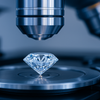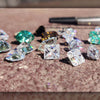
How to Identify a HPHT or a CVD Diamond?
Lab grown diamonds are in high demand in today’s market because of their social, economic, and environmental benefits, causing consumers to understand and learn about them. Primarily, there are two types of lab grown diamonds: High Pressure, High Temperature (HPHT), and Chemical Vapor Deposition (CVD). Even though both are lab produced diamonds, they differ slightly in their production process and qualities. Independent gemstone authorities like the Gemological Institute of America (GIA) identify HPHT and CVD processes using specific indicators, helping jewelers and consumers to settle the HPHT vs CVD identification conundrum.
Despite being produced in diamond labs, lab grown diamonds’ physical and chemical structures are very similar almost identical to a natural diamond’s. Dispelling the wrong idea that lab grown diamonds are a mined diamond’s substitute or copy, such as cubic zirconia that looks like a diamond but differs in composition, lab grown diamonds cannot be differentiated from mined diamonds easily. Expert gemologists and jewelers can only identify CVD or HPHT produced diamonds using advanced technology and tools and under a 10x magnification.
What is a CVD Diamond?
CVD diamonds are produced using the Chemical Vapor Deposition process. A tiny CVD lab grown diamond grows into a full-fledged, large, and pure diamond using carbon gasses, regulated temperature, and pressure, and a sealed vacuum chamber. CVD diamonds’ production includes the following steps:
Vacuum Chamber
Tiny diamond seeds, usually a thin diamond sheet or graphite piece, are placed securely inside a sealed vacuum chamber.
Exposure to Carbon Gasses
The chamber is filled with carbon-heavy gasses like hydrogen or methane.
Raise the Temperature
The temperature inside the chamber is set to 900-1200°C.
Produce Energy
A laser beam breaks down the carbon and ionizes the plasma, then coated on the diamond seed. The energy used to create the laser beam is generated using heating and ionizing plasma.
Remove Imperfections
Scientists remove the diamonds from the chamber every couple of days to polish its top layer, crystalize impurities, and remove extra carbon.
Cutting and Polishing
After three to four weeks, once the diamond seeds are crystalized, they are cut neatly and thoroughly polished.
The CVD process generally takes three to four weeks to transform tiny diamond crystals into the finished product. Producing diamonds using the chemical vapor deposition method involves breaking down the carbon gas to ensure carbon atoms stick to the diamond seeds. Additionally, the number of weeks required to finish a single diamond depends on the chamber’s size, the diamond’s qualities, and the number of diamond seeds available. Usually, before polishing, CVD crystals are brown with a tinge of black graphite. The brown color is removed using heating, and the black graphite is cut.
What is a HPHT Diamond?
HPHT diamonds are lab grown diamonds created using the High Pressure, High Temperature process. Unlike CVD, which exposes a tiny diamond crystal to carbon gasses, HPHT exposes carbon to temperatures and pressures identical to the conditions required to create natural diamonds inside the Earth’s surface. The HPHT lab grown diamonds process includes the following steps:
Customized Press
Scientists place a diamond seed inside a customized press chamber designed for HPHT-produced diamonds.
Control the Temperature and Pressure
The chamber’s temperature and pressure are raised to 1300-1600°C and 870,000 pounds per square inch, respectively, to match the temperature and pressure under which a mined diamond forms.
Carbon Dissolution
The melted metal accelerates the dissolution process of pure carbon sources, and carbon atoms ionize around the diamond seed in layers.
Cutting and Polishing
The ionization of carbon forms a synthetic diamond, which undergoes cutting and polishing.
The chamber designed for HPHT diamonds contains a small filament that increases the chamber’s temperature. Since the filament consists of metals like iron or cobalt, the temperature and pressure required to create lab diamonds are decreased. As a result, the ionized carbon atoms settle down on the cooler parts of the diamond seed and undergo crystallization, creating a synthetic diamond seed. The crystallization process might take a couple of days to a couple of weeks to complete, depending on the availability of diamond seeds, equipment, and the regulated chamber conditions.
Unlike the HPHT vs CVD identification confusion, differentiating between HPHT and mined diamonds is easier. This is because, despite their identical composition, the shapes of their respective diamond crystals differ, affecting their growth process, making it efficient to differentiate between the two.
Identifying HPHT vs CVD Diamonds
Gemologists and organizations like GIA and IGI categorize and identify lab grown diamonds according to indicators:
- Color distribution
- Graining patterns
- Fluorescence color patterns
- Occasional phosphorescence
- Inclusions
- Strain patterns
- Inscription on girdle
Even though both CVD and HPHT diamonds are lab-produced and share an Earth-mined diamond’s physical and chemical composition, the two lab grown diamonds differ in specific properties. Not every lab grown diamond will exhibit the same graining patterns, inclusions, and phosphorescence, which is why GIA published indicators, allowing jewelers and consumers to identify the gemstones.
Color Distribution
The color distribution feature is one of the primary indicators to identify and differentiate between an HPHT and CVD diamond.
HPHT: HPHT-produced diamonds exhibit an uneven color distribution because of the elements involved in their production. The concentration levels of elements like nitrogen inside the HPHT stone give it a geometric pattern. Nitrogen spreads to specific areas of the diamond instead of covering the entire diamond, resulting in uneven color distribution.
CVD: CVD diamonds have an even color distribution. The elements presented during the formation of CVD lab grown diamond, such as hydrogen or methane, break down and spread evenly around the diamond, giving it an even color grading and a standard shape.
Graining Patterns
Lab grown diamonds contain grain inside, but the graining pattern differs in CVD and HPHT diamonds, helping gemologists identify them.
HPHT: An HPHT diamond’s cross-shaped structure and internal growth process give it a definite and distinctive graining pattern, measured using advanced technology and equipment.
CVD: CVD diamonds do not have a geometric shape, criss-cross structure, or a different internal growth composition, resulting in no graining pattern.
Fluorescence Color Patterns
While a natural diamond’s fluorescence is stronger when exposed to long-wave UV lights, lab grown diamonds are more prominent when exposed to short-wave UV lights, giving them a unique fluorescence pattern. Fluorescence colors are generally red, green, orange, and yellow.
HPHT: After cutting, HPHT-produced diamonds present a cross-shaped fluorescence color design on their crown or pavilion.
CVD: CVD diamonds might not always display a fluorescence color pattern, but the pattern is striped when they do.
Occasional Phosphorescence
The phosphorescence of lab grown diamonds refers to their ability to glow for more than a minute after turning off a UV lamp. Natural diamonds generally do not display this feature, suggesting that it is more commonly found among synthetic diamonds. Both CVD and HPHT diamonds show occasional phosphorescence.
HPHT: HPHT lab grown diamonds tend to glow in unnatural colors, such as orange, when kept in the areas immediately after turning off the UV light.
CVD: CVD diamonds show occasional phosphorescence when their color shifts from green to blue due to imperfections caused when they are subjected to intense UV rays during the CVD process also the cvd diamond price is different
Inclusions
Inclusions are imperfections present inside a gemstone that determine its clarity.
HPHT: Lab grown HPHT diamonds have black or opaque metal flux inclusions but display a metallic shine under transmitted rays. Metals used to form synthetic diamonds during the High Pressure; High Temperature method contain cobalt or iron, which merge with the diamond seed and become inclusions. HPHT diamonds have metal inclusions, which pull them towards magnets.
CVD: When it comes to CVD diamonds, they also contain inclusions, but unlike HPHT diamonds, their inclusions are mineral or dark graphite. Since they do not consist of flux metal inclusions, they do not experience a magnetic pull.
Strain Patterns
A diamond undergoes heavy pressure during its formation, such as a shift in the Earth’s plates, and displays a strain or interference color pattern. For instance, the strain pattern is criss-cross and mosaic-shaped in natural diamonds.
HPHT: Even though HTHP diamonds are created under the same conditions as natural diamonds, the pressure and temperature are regulated and controlled, removing any external stress. Since HPHT diamonds do not experience stress, they do not exhibit a strain pattern, also the hpht diamond value is higher then CVD diamond
CVD: On the other hand, CVD diamonds are subjected to fluctuating temperature and pressure, resulting in unique strain patterns.
Inscription on Girdle
In order to differentiate lab grown diamonds from natural diamonds, there is a tiny inscription mark on a lab-produced diamond’s girdle, which can only be viewed under 30x magnification. A diamond’s girdle is its most expansive area that determines the visibility and size of the inscription. If laboratories do not mark synthetic diamonds with inscriptions, organizations that certify diamonds inscribe the girdle. Both CVD and HPHT diamonds have possible inscriptions. For instance, a small laser inscribed on a CVD synthetic diamond’s girdle separates it from mined diamonds in terms of origin.
Wrapping Up
Various features assist consumers and jewelers in differentiating between the two types of lab grown diamonds. Indicators like color distribution, inclusions, and strain patterns make identifying HPHT vs CVD diamonds easier. If you are curious about lab grown diamonds, check out Diamondrensu’s stunning collection of CVD and HPHT diamonds!
Leave a comment
Please note, comments must be approved before they are published.























